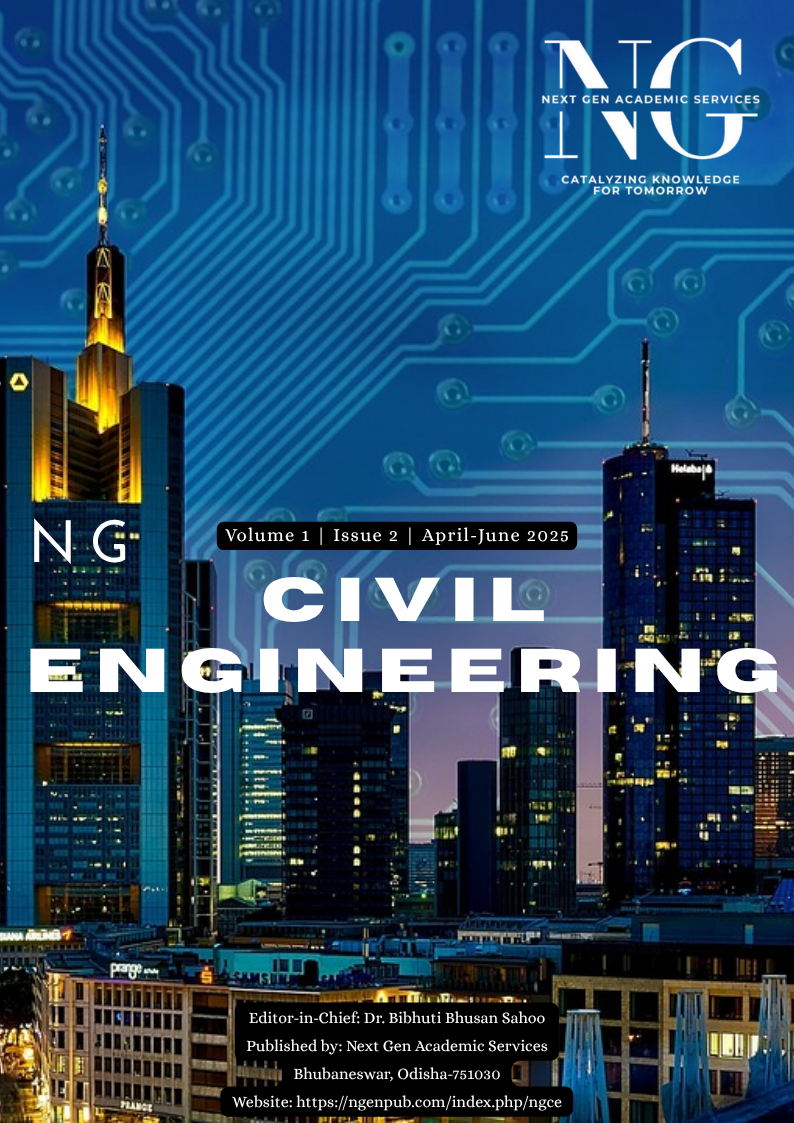Prediction of Runoff Using Hybrid SVM-SSA in Baitarani River Basin, Odisha, India
DOI:
https://doi.org/10.5281/zenodo.15487798Keywords:
Artificial Neural Network, Salp Swarm Algorithm, Support Vector Machine, Willmott’s Index, Monte Carlo Simulation, Rainfall and Runoff modellingAbstract
Accurate prediction of surface runoff is essential for effective water resource management, particularly in regions susceptible to hydrological variability such as the Baitarani River Basin in Odisha, India. Traditional hydrological models often fail to capture the complex, nonlinear, and non-stationary behavior of rainfall-runoff processes, especially under the influence of climatic and anthropogenic changes. In this study, a hybrid model integrating Support Vector Machine (SVM) with Salp Swarm Algorithm (SSA) is proposed to enhance the accuracy of monthly runoff prediction. The performance of the SVM-SSA model is compared against conventional Artificial Neural Network (ANN) and standalone SVM models using datasets from Anandpur and Champua gauging stations. Inputs include rainfall, temperature, specific humidity, and relative humidity, offering a comprehensive representation of climatic influences. Model performance is evaluated using statistical metrics such as Root Mean Square Error (RMSE), Mean Absolute Error (MAE), Coefficient of Determination (R²), and Willmott’s Index (WI). The results demonstrate that the hybrid SVM-SSA model significantly outperforms the conventional models, achieving R² values of 0.9847 and 0.9771 at Anandpur and 0.9844 and 0.9756 at Champua for training and testing phases, respectively. These findings suggest that coupling machine learning with metaheuristic optimization provides a promising approach for runoff prediction in complex river basins.
Downloads
References
Samantaray, S., Das, S. S., Sahoo, A., & Satapathy, D. P. (2022). Monthly runoff prediction at Baitarani River Basin by support vector machine based on Salp Swarm Algorithm. Ain Shams Engineering Journal, 13(5), 101732. https://doi.org/10.1016/j.asej.2021.10.003
Samantaray, S., Sahoo, A., Satapathy, D. P., Oudah, A. Y., & Yaseen, Z. M. (2024). Suspended sediment load prediction using Sparrow Search Algorithm-based support vector machine model. Scientific Reports, 14(1), 12889. https://doi.org/10.1038/s41598-024-50739-w
Darabi Cheghabaleki, S., Fatemi, S. E., & Hafezparast Mavadat, M. (2024). Enhancing spatial streamflow prediction through machine learning algorithms and advanced strategies. Applied Water Science, 14(6), 110. https://doi.org/10.1007/s13201-024-02044-9
Liu, R., Li, G., Wei, L., Xu, Y., Gou, X., Luo, S., & Yang, X. (2022). Spatial prediction of groundwater potentiality using machine learning methods with Grey Wolf and Sparrow Search Algorithms. Journal of Hydrology, 610, 127977. https://doi.org/10.1016/j.jhydrol.2022.127977
Fu, K., Sun, X., Chen, K., Mo, L., Xiao, W., & Liu, S. (2024). Monthly runoff prediction based on Stochastic Weighted Averaging-Improved Stacking Ensemble Model. Water, 16(24), 3580. https://doi.org/10.3390/w16243580
Pachpor, N. N., Kumar, B. S., Prasad, P. S., & Shaikh, S. G. (2024). A Hybrid Feature Selection Gradient Recurrent Neural Network (HFSGRNN) model for rainfall prediction in India regions. International Journal of Intelligent Engineering and Systems, 17(2), 186–196. https://doi.org/10.22266/ijies2024.0430.17
Islam, M. N., & Sivakumar, B. (2002). Characterization and prediction of runoff dynamics: A nonlinear dynamical view. Advances in Water Resources, 25(2), 179–190. https://doi.org/10.1016/S0309-1708(01)00066-2
Remesan, R., Shamim, M. A., Han, D., & Mathew, J. (2009). Runoff prediction using an integrated hybrid modelling scheme. Journal of Hydrology, 372(1–4), 48–60. https://doi.org/10.1016/j.jhydrol.2009.03.030
Pisarenko, V. F., Lyubushin, A. A., Bolgov, M. V., Rukavishnikova, T. A., Kanyu, S., Kanevskii, M. F., ... & Zalyapin, I. V. (2005). Statistical methods for river runoff prediction. Water Resources, 32, 115–126. https://doi.org/10.1007/s11268-005-0017-2
Zhu, M. L., Fujita, M., & Hashimoto, N. (1994). Application of neural networks to runoff prediction. In K. W. Hipel (Ed.), Stochastic and Statistical Methods in Hydrology and Environmental Engineering: Time Series Analysis in Hydrology and Environmental Engineering (pp. 205–216). Springer. https://doi.org/10.1007/978-94-015-8360-5_15
Samantaray, S., & Sahoo, A. (2024). Groundwater level prediction using an improved ELM model integrated with hybrid particle swarm optimisation and grey wolf optimisation. Groundwater for Sustainable Development, 26, 101178. https://doi.org/10.1016/j.gsd.2023.101178
Himanshu, S. K., Pandey, A., & Yadav, B. (2017). Ensemble wavelet-support vector machine approach for prediction of suspended sediment load using hydrometeorological data. Journal of Hydrologic Engineering, 22(7), 05017006. https://doi.org/10.1061/(ASCE)HE.1943-5584.0001532
Deka, P. C. (2014). Support vector machine applications in the field of hydrology: A review. Applied Soft Computing, 19, 372–386. https://doi.org/10.1016/j.asoc.2014.02.002





